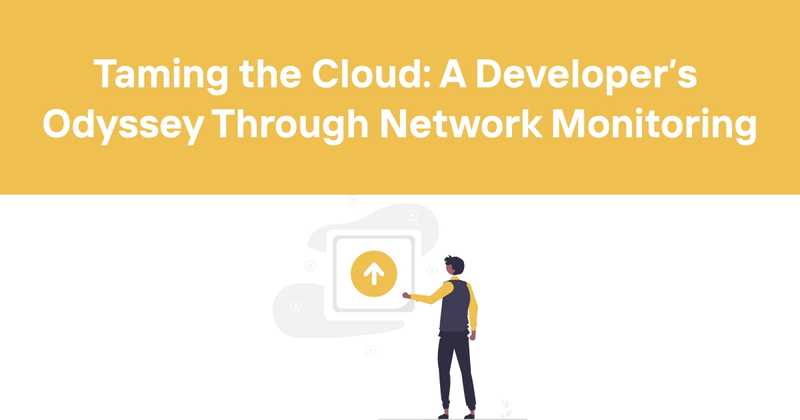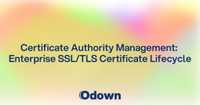Taming the Cloud: A Developer's Odyssey Through Network Monitoring
Cloud-based network monitoring isn't just a fancy buzzword - it's become essential for keeping modern infrastructures running smoothly. As more organizations shift their operations to the cloud, the need for robust monitoring solutions has skyrocketed. But let's be real - navigating the world of cloud monitoring can feel like trying to herd cats while blindfolded.
I've been in the trenches of cloud operations for years, and I've seen firsthand how proper monitoring can mean the difference between smooth sailing and total chaos. So buckle up, fellow developers - we're about to embark on a journey through the wild west of cloud network monitoring.
Table of Contents
- The Cloud Conundrum: Why Monitoring Matters
- Peeling Back the Layers: Types of Cloud Monitoring
- Tools of the Trade: Cloud Monitoring Solutions
- Best Practices: Maximizing Your Monitoring Mojo
- Common Pitfalls: Don't Let These Trip You Up
- The Future of Cloud Monitoring: Crystal Ball Not Included
- Putting It All Together: Your Cloud Monitoring Game Plan
The Cloud Conundrum: Why Monitoring Matters
Picture this: You've just deployed a shiny new application to the cloud. Everything's humming along nicely, and you're feeling pretty darn proud of yourself. Then BAM! Users start complaining about sluggish performance, and suddenly your inbox is flooded with angry emails. Without proper monitoring, you're left scrambling to figure out what went wrong and where.
This scenario is all too common, and it highlights why cloud network monitoring is so crucial. Unlike traditional on-premises setups, cloud environments are dynamic beasts. Resources scale up and down, instances come and go, and your application might be spread across multiple regions or even multiple cloud providers. Trying to keep tabs on all of this manually is about as effective as trying to catch smoke with your bare hands.
Cloud monitoring gives you visibility into the health, performance, and security of your cloud infrastructure. It helps you:
- Identify and resolve issues before they impact users
- Optimize resource usage and control costs
- Ensure compliance with security and regulatory requirements
- Make data-driven decisions about scaling and capacity planning
But here's the kicker - cloud monitoring isn't just about keeping the lights on. It's about gaining insights that can drive your business forward. By understanding how your applications and infrastructure perform in real-world conditions, you can make informed decisions about everything from architecture changes to feature prioritization.
Peeling Back the Layers: Types of Cloud Monitoring
Now that we've established why cloud monitoring is so important, let's break down the different types you might encounter. It's like peeling an onion, except hopefully with fewer tears involved.
Infrastructure Monitoring
This is the foundation of cloud monitoring. It involves keeping tabs on the underlying resources that power your applications - things like:
- CPU usage
- Memory utilization
- Disk I/O
- Network throughput
Infrastructure monitoring helps you ensure that your cloud resources are properly sized and performing as expected. It's also crucial for capacity planning and cost optimization.
Application Performance Monitoring (APM)
APM takes things up a notch by focusing on how your actual applications are performing. This includes metrics like:
- Response times
- Error rates
- Transaction volumes
- User experience
APM tools often provide code-level insights, helping you pinpoint bottlenecks and optimize your applications for peak performance.
Network Monitoring
In the cloud, your network isn't just a bunch of physical cables - it's a complex web of virtual connections. Network monitoring keeps an eye on things like:
- Latency
- Packet loss
- Bandwidth utilization
- DNS performance
Effective network monitoring can help you identify connectivity issues, optimize data transfer costs, and ensure that your applications are responsive no matter where your users are located.
Security Monitoring
With cyber threats constantly evolving, security monitoring is more important than ever. This type of monitoring focuses on:
- Detecting and responding to security incidents
- Identifying vulnerabilities
- Ensuring compliance with security policies
- Monitoring user activity and access patterns
Security monitoring tools often integrate with other security systems to provide a comprehensive view of your cloud environment's security posture.
Log Management and Analysis
Logs are the unsung heroes of cloud monitoring. They provide valuable insights into system behavior, application errors, and security events. Log management tools help you:
- Collect and centralize logs from various sources
- Search and analyze log data
- Set up alerts based on log patterns
- Retain logs for compliance and auditing purposes
Database Monitoring
For many applications, database performance can make or break the user experience. Database monitoring tools focus on:
- Query performance
- Resource utilization
- Replication status
- Storage capacity
By keeping a close eye on your databases, you can optimize queries, plan for scaling, and ensure that your data tier isn't becoming a bottleneck.
Tools of the Trade: Cloud Monitoring Solutions
Alright, now that we've covered the types of monitoring, let's talk tools. The market is flooded with cloud monitoring solutions, ranging from basic freeware to enterprise-grade behemoths. Here are a few popular options to consider:
-
Cloud Provider Native Tools: Each major cloud provider offers its own monitoring solution. Amazon CloudWatch, Azure Monitor, and Google Cloud Monitoring are all solid options if you're primarily using a single cloud platform.
-
Open-Source Solutions: Tools like Prometheus, Grafana, and ELK Stack (Elasticsearch, Logstash, Kibana) are popular open-source options. They offer flexibility and customization but may require more setup and maintenance.
-
Third-Party Commercial Tools: Solutions like Datadog, New Relic, and Dynatrace offer comprehensive monitoring capabilities across multiple cloud platforms and on-premises environments.
-
Specialized Tools: Some tools focus on specific aspects of monitoring, like Splunk for log analysis or Sumo Logic for security information and event management (SIEM).
Choosing the right tool (or combination of tools) depends on your specific needs, budget, and technical expertise. Don't be afraid to mix and match - many organizations use a combination of native cloud tools and third-party solutions to get the best of both worlds.
Best Practices: Maximizing Your Monitoring Mojo
Now that we've covered the what and the how, let's talk about best practices. These are the lessons I've learned the hard way, so you don't have to:
-
Start with clear goals: Before you dive into monitoring, define what success looks like. Are you focused on improving performance? Reducing costs? Enhancing security? Your goals will guide your monitoring strategy.
-
Monitor the right metrics: It's tempting to track everything, but that can lead to information overload. Focus on the metrics that matter most to your business and applications.
-
Set meaningful thresholds: Alerts are great, but too many false positives will lead to alert fatigue. Set thresholds that reflect real issues, not normal fluctuations.
-
Implement proper tagging: In the cloud, resources come and go. Implement a consistent tagging strategy to make it easier to track and categorize your resources.
-
Automate where possible: Use automation to respond to common issues, scale resources, and generate reports. This frees up your team to focus on more complex problems.
-
Regularly review and refine: Your monitoring needs will evolve as your applications and infrastructure change. Regularly review your monitoring setup and adjust as needed.
-
Don't forget the human element: While automation is great, sometimes you need human intuition to solve complex problems. Make sure your team has the skills and knowledge to interpret monitoring data effectively.
-
Plan for scale: As your cloud footprint grows, so will your monitoring needs. Choose solutions that can scale with your business.
-
Consider cost implications: Some monitoring tools charge based on data ingestion or retention. Be mindful of costs, especially as you scale.
-
Integrate with your workflow: Ensure that your monitoring tools integrate with your existing DevOps processes and communication channels.
Common Pitfalls: Don't Let These Trip You Up
Even with the best intentions, it's easy to stumble when it comes to cloud monitoring. Here are some common pitfalls to watch out for:
-
Monitoring everything: Just because you can monitor something doesn't mean you should. Focus on metrics that provide actionable insights.
-
Ignoring application context: Infrastructure metrics are important, but don't forget about the application layer. Understanding how your code performs in production is crucial.
-
Neglecting security monitoring: In the rush to deploy and scale, security often takes a backseat. Don't make this mistake - integrate security monitoring from day one.
-
Failing to correlate data: Looking at metrics in isolation can lead to false conclusions. Learn to correlate data across different systems and services to get the full picture.
-
Overlooking cost monitoring: The cloud makes it easy to spin up resources, but costs can quickly spiral out of control. Make sure you're monitoring and optimizing your cloud spend.
-
Relying solely on averages: Averages can hide important details. Pay attention to percentiles and outliers, especially for performance metrics.
-
Not testing your monitoring: Your monitoring system is critical infrastructure. Test it regularly to ensure it's working as expected, especially your alerting mechanisms.
-
Ignoring the end-user perspective: Internal metrics are important, but don't forget about the user experience. Implement synthetic monitoring and real user monitoring to get the full picture.
-
Failing to document: When an incident occurs, clear documentation can be a lifesaver. Make sure your monitoring setup, alert rules, and runbooks are well-documented.
-
Neglecting log management: Logs can provide invaluable insights, but they're often overlooked. Implement a robust log management strategy from the start.
The Future of Cloud Monitoring: Crystal Ball Not Included
I won't pretend to have a crystal ball, but based on current trends, here are some predictions for the future of cloud monitoring:
-
AI and Machine Learning: Expect to see more AI-powered monitoring tools that can predict issues before they occur and provide intelligent recommendations.
-
Unified Observability: The lines between monitoring, logging, and tracing will continue to blur. Expect more unified observability platforms that provide a holistic view of your systems.
-
Increased Automation: As systems become more complex, manual monitoring will become less feasible. Expect to see more automated remediation and self-healing systems.
-
Edge Monitoring: With the rise of edge computing, monitoring solutions will need to adapt to handle distributed systems at the edge.
-
Compliance and Governance: As regulatory requirements around data and AI become more stringent, monitoring tools will need to evolve to help ensure compliance.
-
Multi-Cloud and Hybrid Monitoring: As organizations adopt multi-cloud and hybrid strategies, monitoring solutions will need to provide unified visibility across different environments.
-
Container and Serverless Monitoring: With the continued adoption of containers and serverless architectures, monitoring tools will need to adapt to these more ephemeral and distributed environments.
Putting It All Together: Your Cloud Monitoring Game Plan
Alright, we've covered a lot of ground. Let's bring it all together with a game plan for implementing effective cloud monitoring:
-
Assess Your Current State: Take stock of your current infrastructure, applications, and monitoring capabilities. Identify gaps and areas for improvement.
-
Define Your Goals: Clearly articulate what you want to achieve with your monitoring strategy. This might include improving performance, reducing downtime, optimizing costs, or enhancing security.
-
Choose Your Tools: Based on your needs and goals, select the monitoring tools that best fit your environment. Don't be afraid to use a combination of tools to cover all your bases.
-
Start Small and Iterate: Begin with monitoring your most critical systems and gradually expand. This allows you to refine your approach and avoid overwhelming your team.
-
Implement Alerting and Escalation: Set up alerts for critical issues and define clear escalation paths. Make sure the right people are notified at the right time.
-
Train Your Team: Ensure that your team understands how to use the monitoring tools and interpret the data they provide. This might involve formal training or hands-on workshops.
-
Continuously Improve: Regularly review your monitoring setup, gather feedback from your team, and make adjustments as needed. Cloud environments are dynamic, and your monitoring strategy should be too.
-
Automate and Optimize: Look for opportunities to automate routine tasks and optimize your monitoring processes. This might include setting up auto-scaling based on monitoring data or automatically generating reports.
-
Plan for the Future: Keep an eye on emerging trends and technologies in cloud monitoring. Be prepared to adapt your strategy as your needs evolve and new capabilities become available.
Remember, effective cloud monitoring is an ongoing process, not a one-time setup. It requires continuous attention and refinement, but the payoff in terms of improved performance, reliability, and cost-efficiency is well worth the effort.
And hey, if all of this sounds overwhelming, don't worry - you're not alone. That's where tools like Odown come in handy. With its comprehensive website and API monitoring capabilities, SSL monitoring, and both public and private status pages, Odown can take a lot of the headache out of cloud monitoring. It's designed specifically for developers like us who need robust monitoring without the complexity.
So whether you're just dipping your toes into the cloud or you're managing a complex multi-cloud environment, remember that effective monitoring is key to your success. Keep learning, stay curious, and don't be afraid to ask for help when you need it. Happy monitoring!



